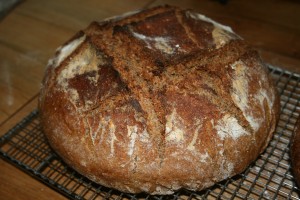
I’ve spent part of the winter developing a reliable Sourdough Bread recipe using 100% of our own sifted whole wheat. Ken has spent part of his winter setting up a horse treadmill connected to a flour mill with a sifter to grind and sift our wheat. Horse Treadmill in Action
Sourdough Whole Wheat Bread
Sourdough Starter – follow a standard recipe to get a mature starter or get some from a friend.
I feed the sourdough every day: Discard all but one Tablespoon of starter and feed it with about ¼ cup of water and 1/3 cup of flour to make a relatively thick paste. If you do this every day or even twice a day, it will stay fresh and be active and ready to bake with anytime. If you are not going to bake for a week it can be kept in the fridge, but it needs to be taken out before your baking day and “woken up” with at least one feeding the night before you intend to bake. I use a small glass container with a plastic lid. If refrigerated it needs to be “fed” at least once a week even if you don’t use it. When the sourdough is fed often enough and mixed with more flour to make a paste like consistency it will have a nutty smell and not be too sour.
I use a scale to measure the ingredients for the bread. I have added times to the following directions to give an idea of when each stage could be done, however the start time can be adjusted to suit your schedule.
Day One – Sourdough – 8:00 a.m.
Measure the following into a bowl:
50 g. mature sourdough starter
200 g. – 90 degree Fahrenheit spring or well water
250 g. – Orchard Hill Farm sifted whole-wheat flour
Mix together and cover
Leave at room temperature 6 to 8 hours.
Final Dough – 2-4 p.m.
792 g. – 90 degree Fahrenheit spring or well water
960 g. – Orchard Hill Farm sifted whole-wheat flour
Mix together, cover and let stand 30 minutes
After 30 minutes add:
432 g. sourdough
25g. sea salt
Wet your hand to work with the dough to keep it from sticking as you do the following:
Wait 15 – 30 minutes and stretch and fold dough, cover.
Wait 15 – 30 minutes and stretch and fold dough again, cover.
Wait 15 – 30 minutes and stretch and fold dough again, cover.
About 5 hours after starting to mix the final dough or when dough is about double in volume:
Divide – 8:00 – 9:00 p.m.
Dust the counter with flour and ease the dough out of its container. Use a dough scraper to cut the dough in half. Shape into a ball with the scraper and your hands. The dough will be very wet, but that is OK. Transfer dough onto a floured piece of linen fabric. The dough does not stick to linen, this is important! (I cut up an old linen tablecloth and it works well.) Gather up the linen cloth by the corners and transfer to a bowl. Repeat with the remainder of the dough.
Proof
Place bowls in a plastic bag and refrigerate over night or for 12 – 13 hours.
Day Two – 8:15 a.m.
Preheat oven to 475 degrees Fahrenheit. Put Dutch ovens, with lids, in oven to preheat and wait about 45 minutes. (If you only have one Dutch oven you can bake the loaves separately, just leave the second in the fridge while the first is baking and reheat the Dutch oven before reusing for about 5 minutes.)
Bake – 9:00 a.m.
With oven mitts carefully remove the Dutch oven from the oven. Remove lid.
Dust the interior of the Dutch oven with rice flour. Lift the dough out of the bowl holding the corners of the linen cloth. Supporting the dough with your hand turn over and gently place the dough into the Dutch oven pull the linen cloth away from the dough. Cover with the lid. Repeat with the second proofed loaf. Place the Dutch ovens into the oven and bake for 30 minutes with the covers on. Remove the covers and continue baking for about 15 minutes. Remove the Dutch ovens from the oven and turn bread out on to a cooling rack. The bread should sound hollow when hit on the bottom and appear well browned. This should result in a crusty loaf with a very moist interior.






